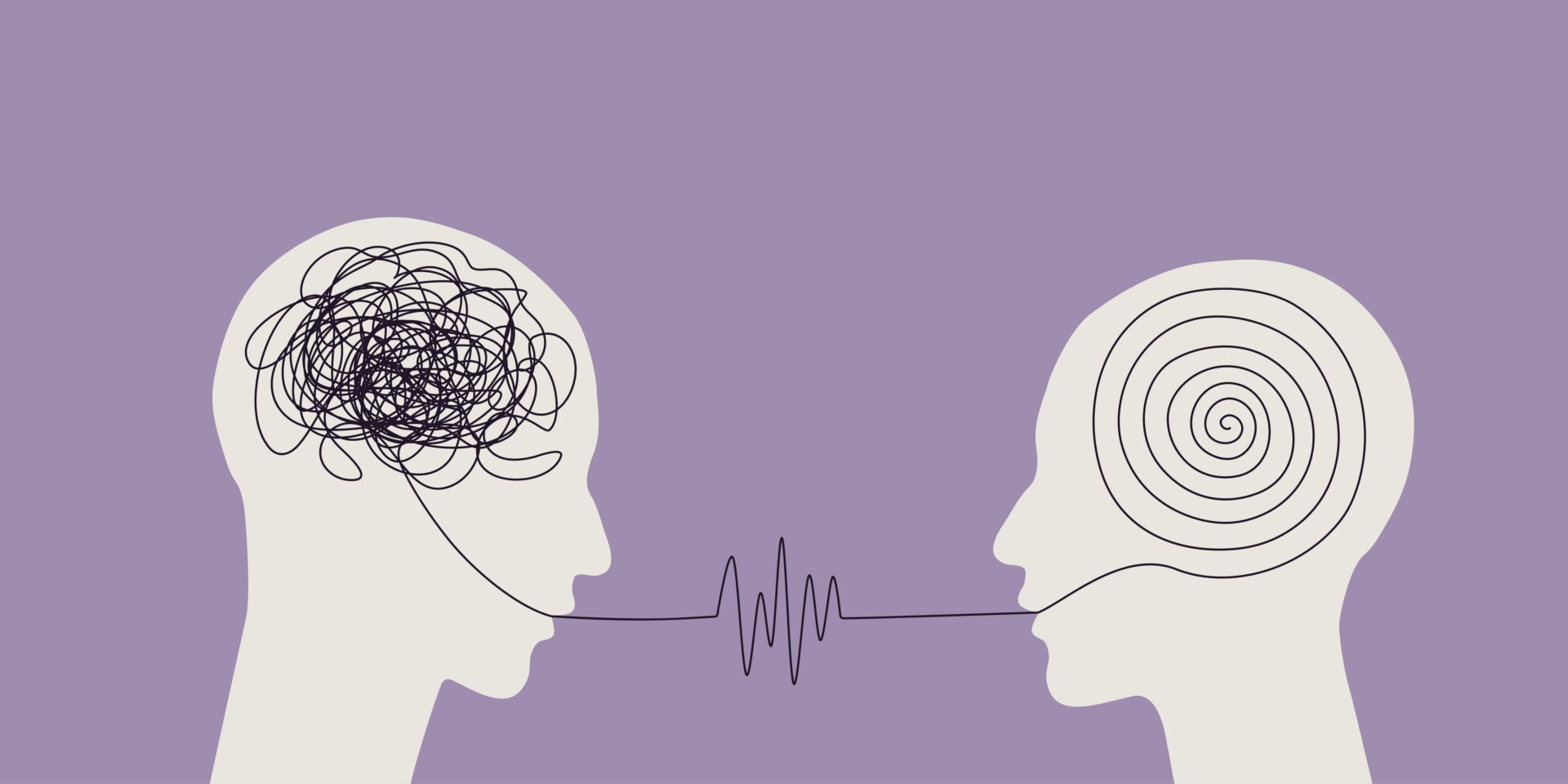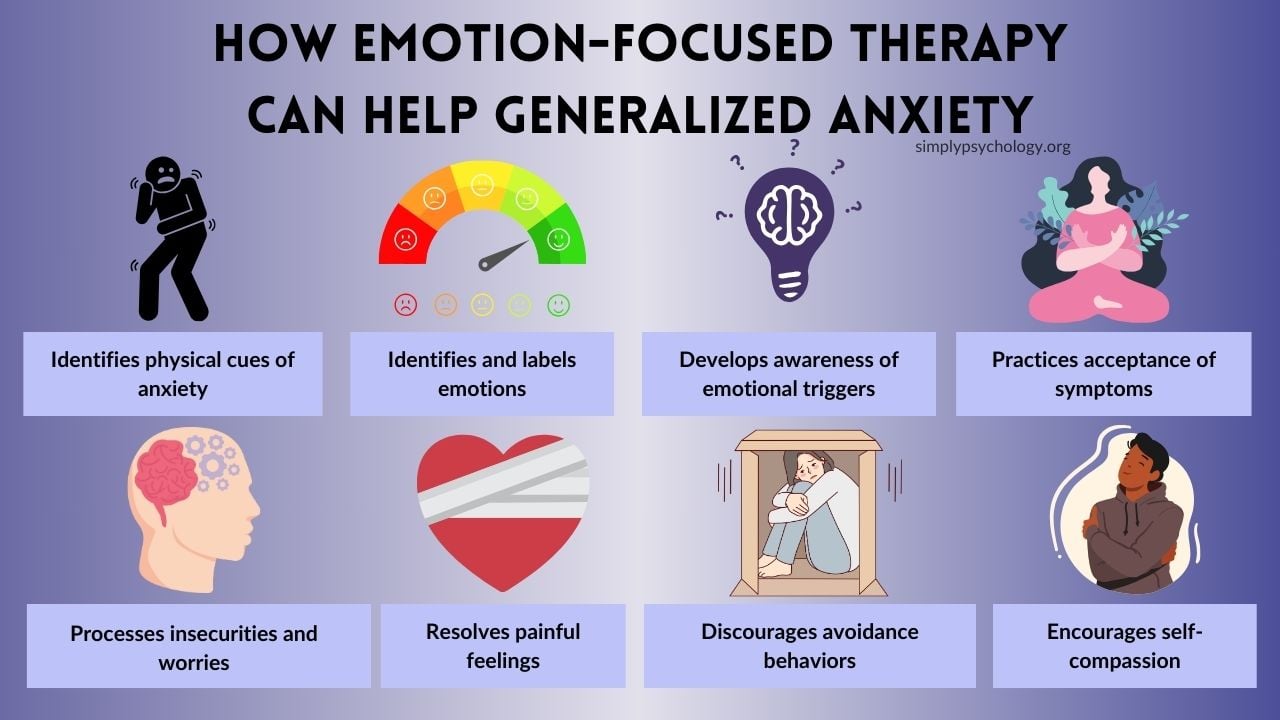Generalized anxiety disorder (GAD) is a complex condition characterized by excessive, uncontrollable worry that is chronic and impairs functioning.
People with GAD experience a range of physical symptoms – muscle tension, restlessness, fatigue – as well as emotional distress from persistent feelings of fear and apprehension. These anxiety symptoms often significantly diminish quality of life across relationships, work, and health domains.
Emotion-focused therapy (EFT) is an experiential form of psychotherapy that helps clients better understand and relate differently to the emotions underlying their anxiety.
EFT facilitates emotional processing, reduces avoidance of anxiety triggers, and empowers clients to cultivate self-compassion. Research shows promising lasting reductions in symptoms of GAD and improved well-being, although more research is needed in this area.

What is Emotion-Focused Therapy?
EFT belongs to the humanistic, experiential tradition of therapies. It has two overarching goals (Greenberg, 2004):
1) To strengthen clients’ sense of self so they feel more able to tolerate and regulate difficult emotions, and
2) To facilitate the processing and transformation of emotion itself through increased awareness, reflection, expression, and meaning-making around feelings.
Therapists create safety to explore emotions through empathic attunement and unconditional positive regard.
Once emotions begin to emerge, therapists help clients symbolize and label them through reflective summaries. This validates and normalizes clients’ experience.
As emotions become clarified, therapists guide clients through chairwork tasks where parts of the self literally speak to each other about areas of emotional conflict and distress. These experiential dialogues increase self-understanding and integration around past injuries and current reactions.
Resolution occurs when opposing parts of the self express care, concern, and understanding toward one another.
How Can EFT Help Treat GAD?
EFT may be a useful treatment for GAD in many ways. Below are some ways in which EFT helps clients work through anxiety and worry:
- Identifying physical cues of anxiety and associated emotions. Therapists teach clients to recognize somatic markers in their bodies that signal mounting anxiety. Through a technique called focusing, clients learn to inquire toward these inner sensations compassionately to help symbolize and label accompanying emotions.
- Developing awareness of emotion triggers. Two-chair dialogues expose automatic cognitive, emotional, and physiological reactions clients have in response to triggering situations. Bringing these patterns into awareness increases the ability to consciously regulate emotions vs react from alarm states that fuel anxiety.
- Practicing acceptance and tolerance of anxiety symptoms. Soothing, empathic reflections from the therapist model the kind of compassion clients can then show themselves in the midst of anxiety. This reduces need to avoid inner experience.
- Using chairwork to dialogue between critical and experiencing parts of self. Core painful feelings and inner conflicts underlying GAD emerge and are resolved through continued chair dialogues between opposing sides of self. New integration promotes self-coherence.
Les Greenburg, clinical psychologist and one of the primary developers of EFT, explains that people with GAD often have an underlying “basic insecurity” of feeling abandoned and unsafe in a dangerous world, so they worry excessively as a “misguided attempt to protect themselves.” EFT aims to get to these core insecurities.
EFT, Greenburg claims, tries to uncover the core painful emotions and insecurities underlying conditions like GAD rather than just treating the surface-level anxiety symptoms.
By getting to the root causes like abandonment, fears, and shame, the therapy can then help clients process and heal from those emotional wounds.

The Role of Emotions in GAD
Emotions like fear, panic, and foreboding drive anxious behaviors and thoughts in GAD.
These primary emotions lurk under the surface, often unidentified yet fueling future-oriented worries and avoidance behaviors that severely constrict functioning.
Difficulty making contact with and accepting such core feelings is what gives them their power over clients.
Learning to approach and understand primary emotions with courage and self-compassion gives clients a sense of agency and control. This shift ultimately empowers them to relate differently to anxiety triggers.
No longer overwhelmed by emotions they cannot name or tolerate, clients realize they have capacities to cope.
Outcomes of EFT for GAD
Research indicates EFT significantly reduces acute symptoms of GAD as well as susceptibility to relapse over the long term.
Unlike other treatments, clients may initially respond but later revert back from gains. EFT appears to endure over time.
Clients also report far greater awareness and understanding of their emotions following EFT, as well as improved ability to regulate emotional reactions even in the face of triggers. This allows clients to stop avoiding anxiety-provoking situations.
No longer flooded by emotions bigger than their window of tolerance, they approach previously overwhelming situations with more willingness and inner resources.
An exploratory study suggests that EFT may be an effective intervention when used in student counselling services and that qualitative data showed decreased anxiety, increased resilience, self-compassion, self-understanding, and assertiveness.
A randomized controlled trial found EFT showed promise as an alternate treatment choice to cognitive-behavioral therapy (CBT) for GAD, with comparable outcomes between the approaches.
Further research with larger samples is warranted to definitively establish the efficacy of EFT relative to established treatments like CBT in order to expand available psychological therapies for clients with GAD.
Considerations
The developmental roots and embedded nature of GAD mean it can take time for clients to strengthen their sense of self and process long-standing emotional injuries from the past.
Therapists should communicate clearly that the length of treatment will vary widely depending on clients’ attachment histories and intrapersonal capacities.
Nonetheless, building a therapeutic relationship with empathy and positive regard is key early on. This alone helps regulate affect and provides enough safety for many clients to slowly risk exploring buried emotions.
Conclusion
In summary, emotion-focused therapy empowers clients with generalized anxiety disorder to cultivate emotional awareness, tolerate anxiety, and ultimately generate self-compassion.
By resolving the inner conflicts that maintain chronic anxiety, EFT facilitates lasting improvements in daily symptoms and quality of life.
More research is still needed, but findings thus far show EFT to be a promising approach in the treatment of this complex disorder.
References
Greenberg, L. S. (2004). Emotion–focused therapy. Clinical Psychology & Psychotherapy: An International Journal of Theory & Practice, 11(1), 3-16. https://doi.org/10.1002/cpp.388
O’Connell Kent, J. A., Jackson, A., Robinson, M., Rashleigh, C., & Timulak, L. (2021). Emotion‐focused therapy for symptoms of generalised anxiety in a student population: An exploratory study. Counselling and Psychotherapy Research, 21(2), 260-268. https://doi.org/10.1002/capr.12346
Timulak, L., Keogh, D., Chigwedere, C., Wilson, C., Ward, F., Hevey, D., Griffin, P., Jacobs, L., & Irwin, B. (2018). A comparison of emotion-focused therapy and cognitive-behavioural therapy in the treatment of generalised anxiety disorder: study protocol for a randomised controlled trial. Trials, 19, 1-11. https://doi.org/10.1186/s13063-018-2892-0
Timulak, L., & McElvaney, J. (2016). Emotion-focused therapy for generalized anxiety disorder: An overview of the model. Journal of Contemporary Psychotherapy, 46, 41-52. https://doi.org/10.1007/s10879-015-9310-7
Watson, J. C., & Greenberg, L. S. (2017). Emotion-focused therapy for generalized anxiety. American Psychological Association. https://doi.org/10.1037/0000018-000
Watson, J., Timulak, L., & Greenberg, L. S. (2019). Emotion-focused therapy for generalized anxiety disorder. In L. S. Greenberg & R. N. Goldman (Eds.), Clinical handbook of emotion-focused therapy (pp. 315–336). American Psychological Association. https://doi.org/10.1037/0000112-014

